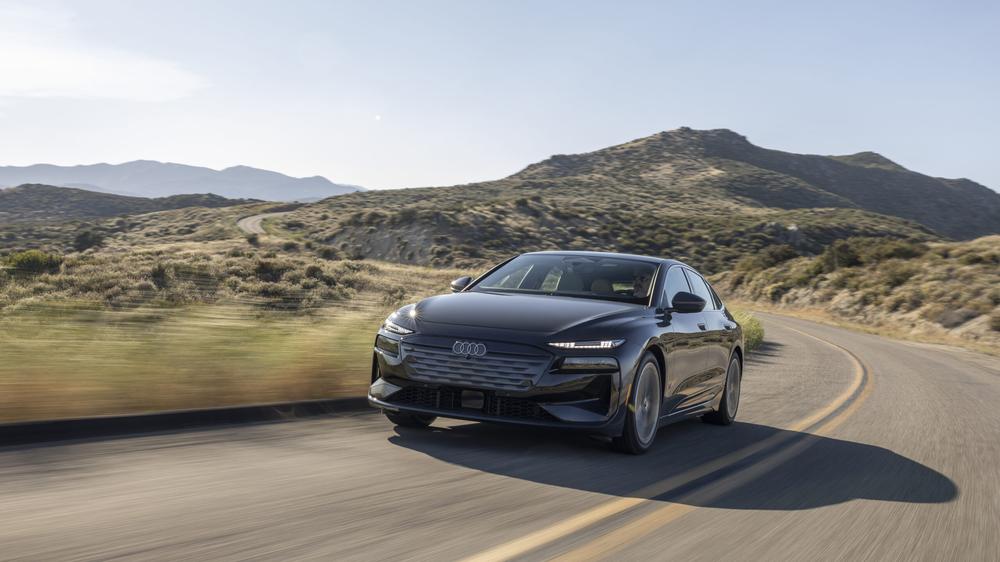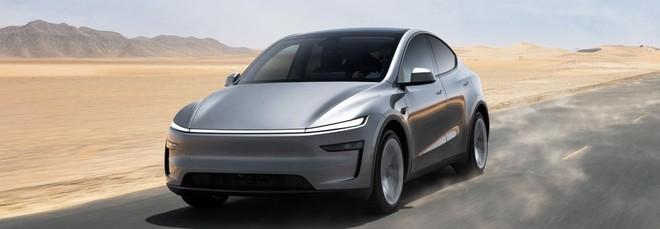For much of my lifetime, the auto industry has been dominated by the German carmakers. As they battled for supremacy, their engineers came to dictate what we think of as performance and luxury in cars. Now the battleground is a new generation of electric vehicles, and the Germans are playing catch-up. Hyundai stole a march on them as the first established OEM with an 800 V platform that charged faster and drove more efficiently than anything else we’d seen to date, and those cars continue to accrue plaudits. Soon, BMW will launch its Neue Klasse platform with the iX3, and our first drive in Mercedes-Benz’s new CLA was promising. But Audi was the first of the German companies to ready its own purpose-built 800 V EV platform, and it has followed up the Q6 e-tron SUV with today’s pair of electric fastback sedans, the A6 Sportback e-tron and its hotted-up variant, the S6 Sportback e-tron.
Yes, technically, Audi had an 800 V EV a while ago, a rebadged version of the mighty Porsche Taycan. That car still exists and now goes extremely quickly, but the A6’s architecture—called Premium Platform Electric, or PPE—takes lessons from the Taycan and combines them with the latest in software-defined vehicles, where a handful of powerful computers replace hundreds of individual discrete controllers around the car. It all comes wrapped up in a highly aero-efficient shape that still manages to light up the relevant bit of a car-spotter’s brain that identifies Audis.
A6 or S6?
In Europe, there’s the option of a proper station wagon version, or Avant in Audi-speak; we might see that body variant for an RS6 Avant e-tron in the future, but for now, it’s just the A6 and S6 Sportbacks. Both variants use the same 100 kWh (94.4 kWh useable) battery pack, made up of prismatic cells. The A6 can be had in rear- or all-wheel drive; the former makes do with a 375 hp (280 kW) drive unit, the latter with a combined 456 hp (340 kW) thanks to an asynchronous motor on the front axle that complements the rear’s permanent magnet synchronous motor. Actually, both those power outputs are for peak power, should you engage launch control. Nominal power output is a little lower, at 362 hp (270 kW) and 422 hp (315 kW), respectively.
The single-motor A6—starting MSRP $65,900—is the one to get if you need to go long distances: In Ultra trim, it has an EPA range of 392 miles (630 km). Adding quattro to the mix bumps the price up by a couple thousand dollars, and the range takes a slight dent down to 377 miles (607 km) as long as you still specify the Ultra package and stick to 20-inch wheels. Two motors get you to 60 mph almost a second faster than just one—4.3 seconds versus 5.2—when using launch control.
Fast charging lives up to the name, with rates of up to 270 kW and a 10–80 percent charge time of just 21 minutes. Based on experience with the closely related Q6 e-tron, those times should be considered legit. For now, the A6 (and S6) comes fitted with a CCS1 charge port—you’ll need a NACS adapter to charge at the more numerous but less powerful Tesla Superchargers. You can only fast charge from the driver’s side, but the passenger side has a second J1772 port, so AC charging can be dealer’s choice. AC charging maxes out at 9.6 kW, and should take about 11.5 hours to fully charge a depleted pack.
We’ll try to review one of the rear-drive hypermilers in the coming months, providing Audi adds one to its fleet of press cars. For the North American first drive, we were able to get some seat time in an A6 Sportback e-tron quattro with the Prestige pack ($74,200).
The more powerful $78,700 S6 Sportback e-tron is only available with all-wheel drive, with a nominal output of 496 hp (370 kW) and maximum power output of 543 hp (405 kW). Top speed is higher in the S6 by an academic 19 mph (30 km/h), with a zero-to-60 time of 3.7 seconds (3.9 seconds to 100 km/h). In our Prestige trim, the S6 was outfitted with diamond-stitched sports seats and Alcantara—or some other artificial suede—on the dash. Range suffers, though, at 324 miles (521 km).
The car’s cabin layout and ergonomics are starting to feel familiar at this point—it shares much not only with the electric Q6 e-tron but also Audi’s new midsize combustion cars, the A5 and Q5. (We’ll leave for now the fact that a combustion A6, unrelated to today’s vehicle in virtually all but name, is also in development, bringing an end to the “odd numbers for ICE, even numbers for EV” convention that briefly took hold at the automaker. Now nameplate chaos reigns.)
Hey Audi...
The voice control proved a frustrating alternative to using the touchscreen, with a lot of “I’m sorry I can’t do that” and “can you ask me that again” for commands that I’m pretty sure ought to have worked. But both the A6 and S6 felt mature in terms of software, something that wasn’t true for the same infotainment platform a year ago. I remain frustrated with how limited the UI options remain for the main instrument display, however.
I keep writing this, but Audi pioneered the use of high-resolution digital displays instead of analog dials and gave owners quite a lot of choice, including the option of a moving map for navigation. Now, there’s a way to make the display very minimal, which would be useful at night, but otherwise, you’re extremely limited in what you can display in front of you. The optional full-color heads-up display has the same augmented-reality direction tech that we’ve seen in other luxury cars, and it remains helpful when driving on unfamiliar roads, although that requires using the native navigation app; Apple CarPlay users should still see turn-by-turn directions on the HUD, though.
There’s no true one-pedal driving mode, just a choice between B—0.25 G of lift-off regeneration deceleration—and D, which can be toggled between none, 0.06 G, and 0.15 G of lift-off regen braking using the paddles behind the steering wheel. B is preferable when the road turns twisty, something both A6 and S6 coped with surprisingly well. Hairpins proved the steering and suspension rapid enough to rotate the car quickly, and what felt like numb steering initially began to reveal some information about road surfaces and available grip as the road surface changed then changed again. There’s also a noticeable difference between the drive modes. Comfort feels a little soft and wallowing, Dynamic effectively transfers more bumps into the cabin, and Balanced is a rather good midpoint between the two, and where I spent most of my time. I should also note the lack of fatigue I felt despite a full day behind the wheel of both cars.
With such a low drag coefficient—0.23, which could be as little as 0.21 if the US allowed side cameras instead of mirrors—there’s very little wind noise at speed, and the car coasts pleasingly, if you’re in D and have set the car to no lift-off regen. Coupled with a comfortable ride, it’s easy to find yourself going faster than expected, a trait shared with some other Audis of late.
Audi’s advantage against its German rivals is that the A6’s competition isn’t quite as cutting edge. There are the anodyne curves of the Mercedes EQE sedan, which makes do with a less capable powertrain and an interior that feels a little too lightweight at times. BMW’s i5 is a newer alternative but shares a platform with the combustion-powered 5 series. While I have a lot of respect for BMW’s powertrain-agnostic CLAR platform, there’s a reason it has gone EV-only for the Neue Klasse, which will launch in a smaller segment when it debuts, anyway. I’m not sure the added power of the S6 is entirely necessary, but I do like the interior upgrades, and it was entertaining on a narrow stretch of Highway 33, considering a curb weight of over 5,000 lbs (2,267 kg).
I am looking forward to that electric RS6, though.

 Uber’s making it easier for women riders and drivers to find each other
Uber’s making it easier for women riders and drivers to find each other